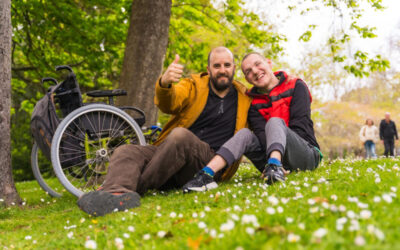In a world where diversity is increasingly valued, it’s essential to recognise and celebrate the unique experiences and contributions of the Deaf community.
Deaf inclusion is about creating a society where deaf people or those hard of hearing can participate fully and access services without barriers. At Bloom Healthcare we understand the importance of celebrating diversity through deaf inclusion and provide strategies for promoting accessibility.
What is Deaf Inclusion?
Deaf inclusion means creating an environment where people with hearing impairment can participate in activities, access services, and communicate effectively without any barriers.
Deaf inclusion involves acknowledging and respecting the differences between deaf and hearing individuals and taking steps to accommodate those differences. Examples of deaf inclusion can include:
- Providing a sign language interpreter in public spaces
- Captioning videos and films for accessibility
- Offering visual language aids such as diagrams and graphics
- Creating quiet spaces for individuals who are sensitive to background noise
- Providing assistive technology devices such as hearing aids and cochlear implants
Deaf inclusion is essential for individuals who are deaf or hard of hearing to live their lives independently and access services like education, healthcare, and employment. It also benefits society as a whole by promoting diversity and inclusivity.
The Significance of Celebrating Diversity
Celebrating diversity is an essential component of Deaf Awareness. It allows us to recognise and celebrate the unique contributions and experiences of the Deaf community. Deaf inclusion plays a crucial role in promoting diversity and celebrating differences. By acknowledging and embracing differences, we can create an environment that is accepting and welcoming to everyone, regardless of their abilities or background.
The benefits of diversity and inclusion go beyond just promoting tolerance and acceptance.
Studies have shown that diverse teams are more innovative, creative, and productive. They also lead to better problem-solving and decision-making. By promoting diversity and inclusion, we can tap into the full potential of individuals and create a more equitable and just society.
Overcoming Barriers to Deaf Inclusion
Despite the efforts to promote deaf inclusion, there are still many barriers that deaf and hard-of-hearing individuals face. Some of the common barriers include:
- Lack of awareness and understanding of the needs of deaf individuals
- Inaccessible physical environments and public spaces
- Limited access to technology and assistive listening devices such as hearing aids
- Limited job opportunities and workplace accommodations
- Stigma and discrimination
To overcome these barriers, the team at Bloom Healthcare takes a multi-faceted approach that includes deaf education, advocacy, and policy changes. Some strategies for promoting deaf inclusion include:
- Raising awareness about the needs of deaf and hard-of-hearing individuals
- Providing training for individuals and organisations to better understand deaf culture and communication
- Advocating for accessibility laws and policies
- Promoting the use of assistive technology and devices
- Encouraging employers to provide workplace accommodations for deaf individuals
- Providing resources and support for deaf individuals and their families
Accessibility is also crucial in promoting deaf inclusion. This can include providing captioning, sign language interpreters, and visual aids to make information and services accessible to all.
Deaf inclusion is an essential component of promoting diversity and celebrating differences.
By acknowledging and embracing the unique needs and experiences of the Deaf community, we can create a more inclusive and accepting society. Overcoming barriers to deaf inclusion requires a collective effort that involves education, advocacy, and policy changes.
By working together, we can promote accessibility and celebrate diversity during Deaf Awareness Week and beyond.




